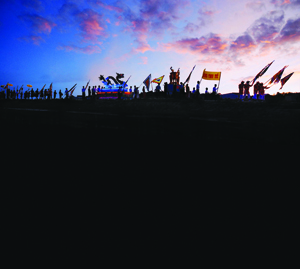(No.4, Vol.7,Aug-Sep 2017 Vietnam Heritage Magazine)

A procession in the early morning of the Autumn Consecration Festival, Chuon Village, Thua Thien Hue Province
Photo: Nguyen Dang Hanh


At An Truyen Temple, at the Autumn Consecration Festival, Chuon Village, Thua Thien Hue Province. The elders preparing the
offerings worshipping the gods. Photos: Canh Tang
Chuon Village, also called An Truyen, stands between paddy fields and the vast Chuon Lagoon. Just about 10km from the royal palaces of past Nguyen Kings, it belongs to Phu An Commune, Phu Vang District of Thua Thien Province.
During the Nguyen Dynasty, Chuon Village was famous for having many wise scholars working in the court. The villagers were also famous for civil disobedience and having rebelled against King Tu Duc’s court. At that time, rice wine made in Chuon Village was well-known for its unique, distinct flavour that mesmerized the Royal family and courtiers at the Capital Citadel.
Chuon has changed though, because many villagers became wealthy, and the village continues to attract visitors. The first thing they come for is the old temple called An Truyen. Some say, ‘Not having seen An Truyen Temple means not knowing Chuon.’
An Truyen was so impressive during the Nguyen Dynasty because many high- ranking, wealthy courtiers lived in Chuon.
The website of the People’s Committee of Thua Thien Province says An Truyen Temple was built in the 14th century and has been a national cultural relic since 1994. It stands at the center of the village, with a lotus pond and breezy Chuon Lagoon in front of it. Built on an area of 420m2, consisting of three structures – the Front Edifice, the Frontal Consecration Hall, and the Rear Edifice – the temple is dedicated to the seven ancestors of the seven clans of Chuon Village. Wooden items inside are expertly carved, most notably the altars decorated with dragons, phoenixes, kylins and flowers.
But visitors are also drawn to the rice wine that had the power to lift the spirit of kings. Today, there are about 100 distileries that spread the aroma around the village of over 1,000 households, 60 per cent of which live by farming and fishing in Chuon Lagoon.
Visitors can also learn about the trade of making dumplings and glutinous rice cakes.
The best time to visit Chuon Village is during the 15-17th of the 7th lunar month. This is the time Chuon villagers conduct their Autumn Consecration.
Culture experts find this ceremony unique to Chuon compared to the consecration rituals elsewhere. Autumn Consecration is when Chuon villagers pay respect to the first men of the Nguyen, Ho and Dam families, founders and Guardian Lords of the village.
On the 15th they have the Full Moon Prayer ceremony at An Truyen Temple. Early on the morning of the 16th, villagers headed by their elders, have a procession to receive the Guardian Lords’ votive tablets from their shrine in the paddy field to the temple. Here the chief priest conducts sacred rituals dedicated to the ancestors and deities and prays for good weather, good crops, good health, peace and happiness for everybody.
From 4 to 5 a.m. on the 17th, they have another procession to see the Guardian Lords back to their shrine. This is the most interesting part of the three-day ceremony.
Leading the procession are three intricately carved wooden palanquins, flags and parasols with an ancient design, followed by an assembly of traditional musical instruments playing melodic traditional thai tunes. Everybody is dressed in an ancient style according to their assigned role.
The procession moves slowly, step by step, on the 1km road from the temple to the shrine.
A tourist named Thuy recounted, ‘The palanquins, accompanied by old-fashioned music, move on the dyke under the parasols, casting colorful shades on the sky, followed by the villagers. The whole procession is reflected in the lagoon in the early morning. A very picturesque scene indeed!’

